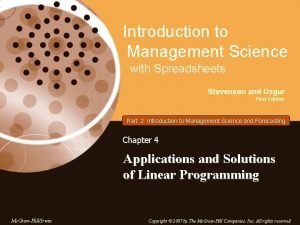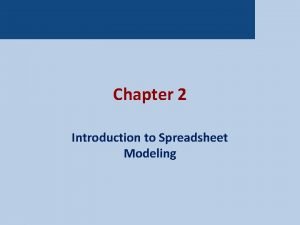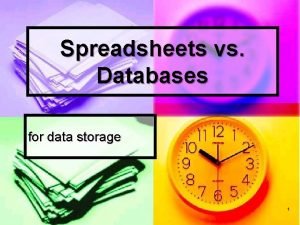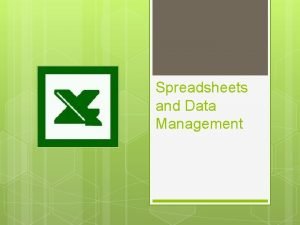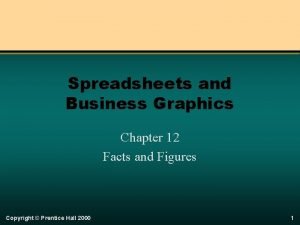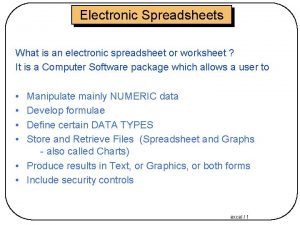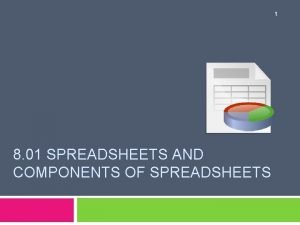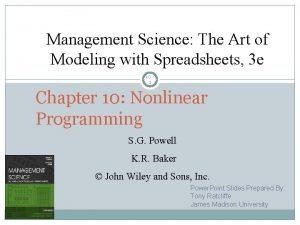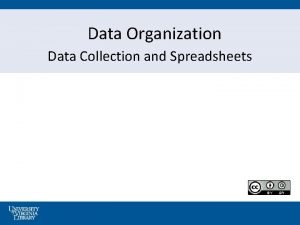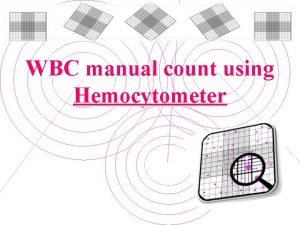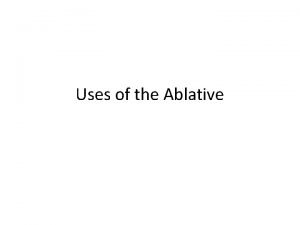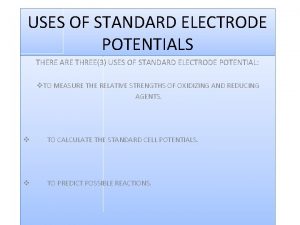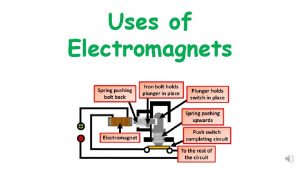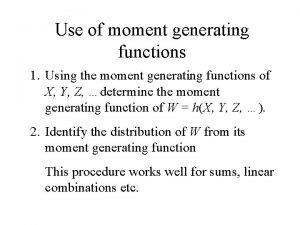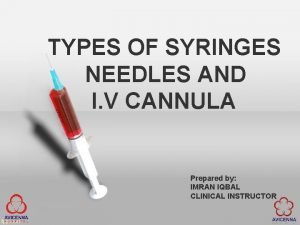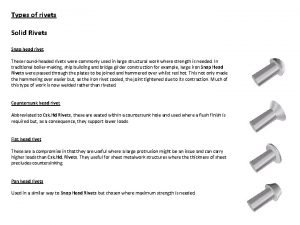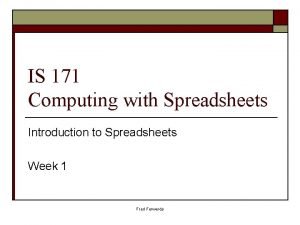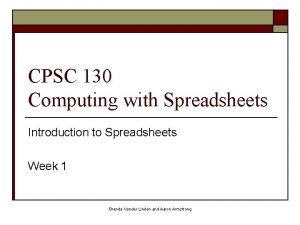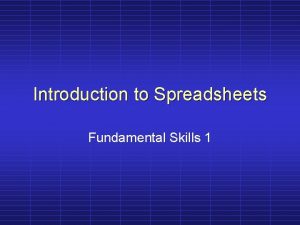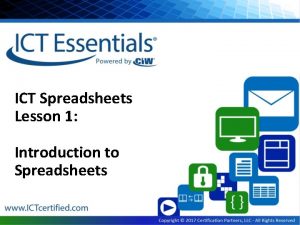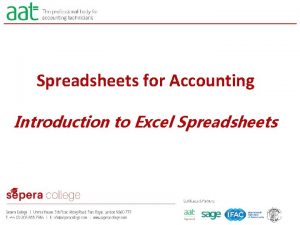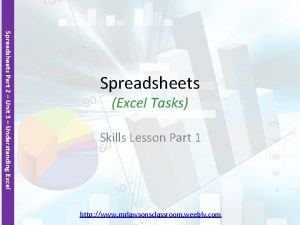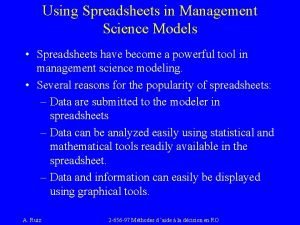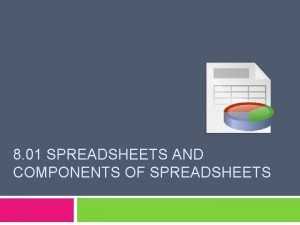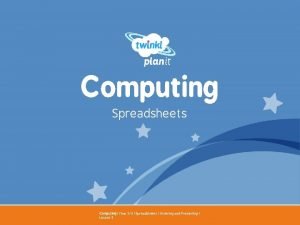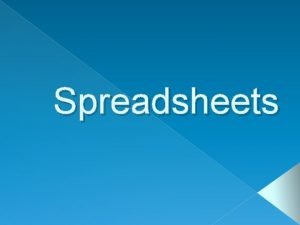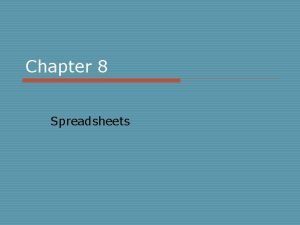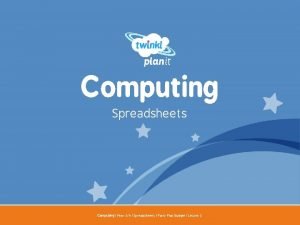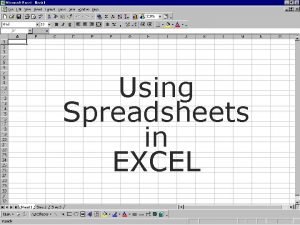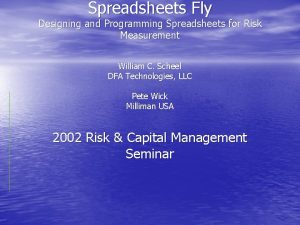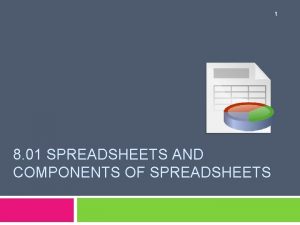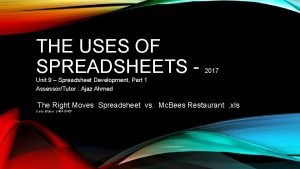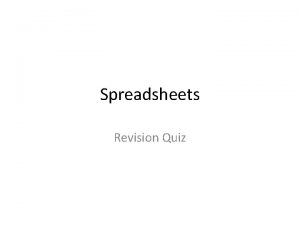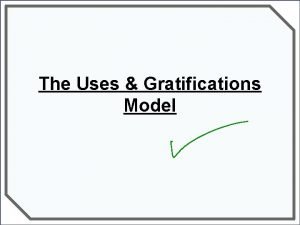Introduction to Spreadsheets What are Uses of Spreadsheets

























- Slides: 25

Introduction to Spreadsheets

What are Uses of Spreadsheets? Prepare budgets Maintain student grades Prepare financial statements Analyze numbers Manage inventory Make forecasts

Advantages of Spreadsheets Forecasting and making decisions Fast and efficient Automatically recalculates

What-if Analysis A spreadsheet tool used to play out different situations to determine the outcome

Spreadsheet Terminology Cell – the intersection of a row and a column Active cell - The cell in which you are currently working. Cell address - The location of a cell as identified by the column letter and row number.

Parts of the Spreadsheet Window Active cells Column C Row 5

Entering Data into a Spreadsheet Labels – Alphabetical text on a spreadsheet. They tell you what the values mean. Values – A number entered into a spreadsheet Formulas – Statement that performs a calculation Functions – Built-in formula that is a shortcut for common calculations

Identifying Labels and Values labels values

Identifying Formulas and Functions formula The result of the formula function The result of the function

Identifying Parts of a Spreadsheet Formula mathematical operators =B 2+C 2+D 2 equal sign—first part of any spreadsheet formula cell reference/address— made up of the column heading and the row number

Identifying Parts of a Spreadsheet Function =SUM(B 2: B 6) name of function equal sign range

Mathematical Operators + * / addition subtraction multiplication (asterisk) division (slash or diagonal)

Spreadsheet Functions Function Name AVERAGE COUNT IF MAX MIN ROUND SUM Description Average of arguments. Counts the number of cells in a range. Specifies a logical test to perform; then performs one action if test result in true and another if it is not true. Maximum value of range of cells. Minimum value of range of cells. Rounds a number to a specified number of digits. Totals a range of cells.

Relative and Absolute Referencing Relative – cells that change when they are copied into other cells Absolute – cells that do not change regardless of where it is copied

Changing Column Width 1. Position cursor between column headings. 2. Make sure your cursor changes to cross-hairs. 3. Click and drag to the right. Shortcut: double-click between the column headings!

Changing Row Height 1. Position cursor between row headings. 2. Make sure your cursor changes to cross-hairs. 3. Click and drag down. Shortcut: double-click between the row headings!

Formatting Cells with Enhancements underline shading font size bold borders

Numeric Formatting decimal general currency

Print Orientations Portrait – A paper orientation that is taller than it is wide. Landscape – A paper orientation that is wider than it is tall.

Print Options without gridlines with gridlines

Printing Column and Row Headings without column and row headings with column and row headings

Print Showing Formulas formulas displayed formulas NOT displayed

Printing Selected Areas highlight desired area, choose option to print selected area (according to your software)

Graphing bar graph – used to compare the values of various items line graph – useful for plotting trends area graph – like a “filled in” line graph. Used to track changes over time pie graph – used to represent the percentage each item contributes to the total

Types of Charts/Graphs
 Insidan region jh
Insidan region jh Introduction to management science with spreadsheets
Introduction to management science with spreadsheets What are spreadsheet models
What are spreadsheet models Spreadsheet vs database
Spreadsheet vs database Spreadsheets
Spreadsheets Facts about spreadsheets
Facts about spreadsheets Electronic spreadsheet in computer
Electronic spreadsheet in computer Spreadsheet uses
Spreadsheet uses Management science the art of modeling with spreadsheets
Management science the art of modeling with spreadsheets A collection of spreadsheets
A collection of spreadsheets Body paragraph
Body paragraph Sources and uses of funds
Sources and uses of funds Semicolon lab
Semicolon lab Well labelled diagram of hot air oven
Well labelled diagram of hot air oven Chromatography uses
Chromatography uses Rbc thoma pipette
Rbc thoma pipette Ablative uses
Ablative uses Daniel cell uses
Daniel cell uses Uses of ethanol
Uses of ethanol Electromagnetism uses
Electromagnetism uses Uses and gratification theory
Uses and gratification theory Mgf of normal distribution
Mgf of normal distribution Comparison between virtual circuit and datagram network
Comparison between virtual circuit and datagram network Flow rate of iv cannula
Flow rate of iv cannula Types of rivets
Types of rivets Digoxin uses
Digoxin uses

